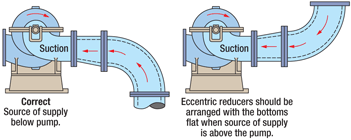What length must an eccentric reducer be on a centrifugal pump from pump port to pipe Connection?
Eccentric reducer is typically installed at the centrifugal process pump suction nozzles in order to facilitate proper transition from the the larger diameter (low flow velocity, moderate friction loss) suction piping to the pump suction nozzle.
Designer has to pay attention to the proper installation of eccentric reducers at the suction piping of pumps. They must be installed in a proper way so that entrapped air or vapours will not accumulate in any portion of the pipe reducer. Entrapped vapour bubbles can reduce a pump’s suction line cross-sectional area. If this happens, then flow velocities will increase and so will friction losses, leading to an adverse effect on pump performance and long-term reliability.
Eccentric reducers installation instructions
When the source of supply is above the pump, then the eccentric reducers must be placed with the flat side at the bottom.
 Picture 1 – Eccentric reducers installation when source of supply is below or above the pump suction nozzle
Picture 1 – Eccentric reducers installation when source of supply is below or above the pump suction nozzle
In case of long horizontal pipe runs, air pockets are avoided by installing the eccentric reducer with the flat side up.
 Picture 2 – Eccentric reducers installation in case of long horizontal pipe runs
Picture 2 – Eccentric reducers installation in case of long horizontal pipe runs
In case the source of supply comes from below the pump, then the eccentric reducer has to be installed with the flat side up, as indicated in Picture-1.
Straight length requirement for pump suction piping
Whenever a low point exists at the pump’s suction line and a concentric reducer is used at pump suction nozzle, it is possible to have vapour accumulation close to the pump suction nozzle (Picture-2). In such cases, it is highly recommended that the straight horizontal pipe run is kept to a minimum. Most often, in such installations, the reducer flange is directly connected at the pump’s suction nozzle: there is no straight length of piping between the reducer outlet and the pump nozzle.
Straight pipe lengths are however connected to the inlet flange of an eccentric reducer.
Five (5) diameters of straight length of piping upstream the reducer is usually considered as good engineering practice. In case several improperly specified parameters come into the equation (e.g. viscosity changes etc), then it would be prudent to install as many as ten (10) diameters of straight piping next to the reducer inlet flange. A number ranging between five (5) to ten (10) diameters of straight pipe run is typically the recommended value in published technical literature.







0 comments:
Post a Comment